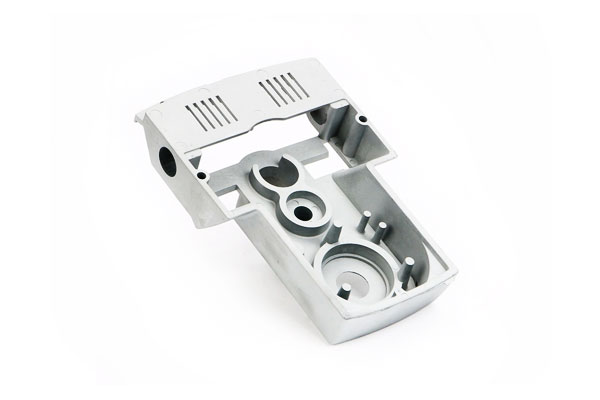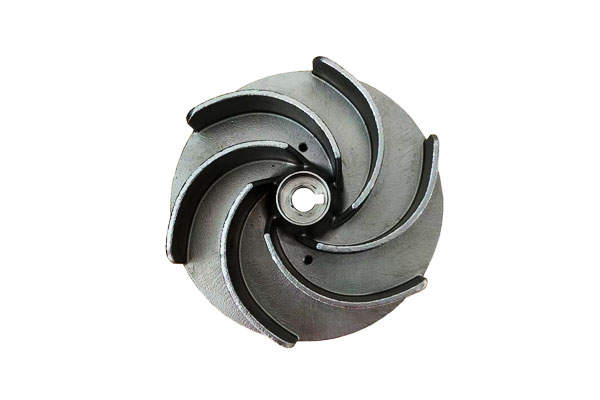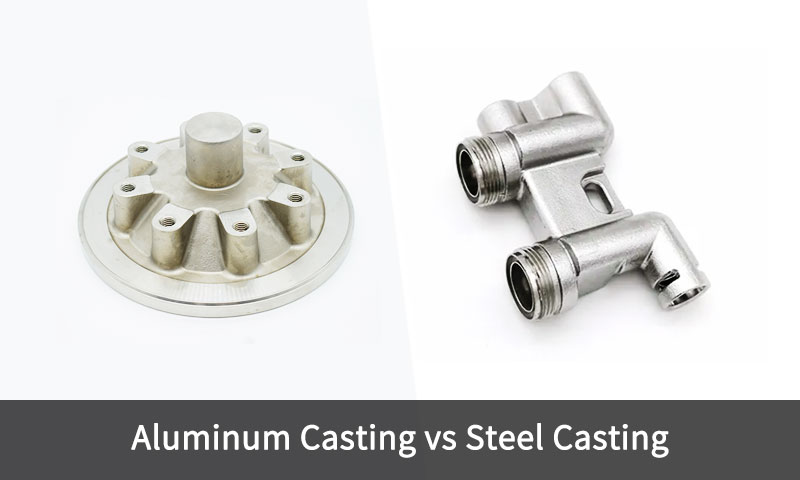1. Wstęp
Odlew aluminiowy a odlew stalowy — wybór pomiędzy tymi dwoma podstawowymi materiałami kształtuje wydajność komponentów, kosztów i możliwości produkcyjnych w różnych branżach, od motoryzacji po energetykę.
To porównanie nie dotyczy tylko chemii metali: obejmuje gęstość i sztywność, Zachowanie termiczne, zgodność procesu odlewania, przetwarzanie wtórne (obróbka cieplna, Inżynieria powierzchniowa), koszt cyklu życia i niezawodność specyficzna dla aplikacji.
Inżynierowie i nabywcy muszą zatem ocenić cały system – ładowanie, temperatura, środowisko, wielkość produkcji i wymagania dotyczące wykończenia – przed określeniem trasy metalu i odlewu.
2. Podstawowe różnice materiałowe między aluminium a stalą
U podstaw aluminium vs. Odlewanie stali to podstawowy kontrast metalurgiczny i fizyczny, który bezpośrednio wpływa na zachowanie każdego materiału podczas odlewania, obróbka, i usługa.
| Nieruchomość | Aluminium (NP., Al-i Allays) | Stal (NP., stale węglowe lub niskostopowe) | Implikacje inżynierskie |
| Gęstość (g/cm³) | 2.70 | 7.85 | Aluminium jest o ~65% lżejsze, oferując znaczną oszczędność masy w transporcie i lotnictwie. |
| Punktem topnienia (° C.) | 615–660 | 1425–1540 | Niska temperatura topnienia aluminium umożliwia łatwiejsze odlewanie i mniejsze zużycie energii; stal wymaga specjalistycznych pieców. |
| Przewodność cieplna (W/m · k) | 120–180 | 40–60 | Aluminium efektywnie odprowadza ciepło – idealnie nadaje się do silników, wymienniki ciepła, i elektronika. |
| Specyficzna siła (MPA/ρ) | ~ 100–150 | ~ 70–90 | Pomimo niższej siły bezwzględnej, stosunek wytrzymałości do masy aluminium jest lepszy od stali. |
| Moduł sprężystości (GPA) | 70 | 200 | Stal jest sztywniejsza, zapewniając lepszą sztywność pod obciążeniem i wibracjami. |
Odporność na korozję |
Doskonały (tworzy warstwę Al₂O₃) | Zmienny; podatne na rdzę bez powłok | Aluminium jest naturalnie odporne na utlenianie, podczas gdy stal wymaga ochrony powierzchni (malarstwo, platerowanie, lub tworzenie stopów z Cr/Ni). |
| Maszyna | Doskonały | Umiarkowane lub trudne | Miękkość aluminium umożliwia łatwą obróbkę i krótsze czasy cykli; stal wymaga mocniejszego oprzyrządowania. |
| Recyklabalność | >90% do odzyskania | >90% do odzyskania | Obydwa materiały w dużym stopniu nadają się do recyklingu, chociaż przetapianie aluminium wymaga mniej energii (5% produkcji pierwotnej). |
| Skurcz odlewniczy (%) | 1.3–1,6 | 2.0–2.6 | Stal kurczy się bardziej podczas krzepnięcia, wymagające większych naddatków i bardziej złożonych systemów bramkowania/zasilania. |
| Koszt (ok., USD/kg) | 2.0–3.0 | 0.8–1,5 | Aluminium jest droższe w przeliczeniu na kilogram, ale oszczędności w wadze i przetwarzaniu mogą zrekompensować całkowite koszty cyklu życia. |
3. Co to jest odlew aluminiowy?
Aluminium odlew to proces kształtowania stopionego aluminium lub jego stopów w kompleks, elementy o kształcie zbliżonym do netto przy użyciu form.
Jest to jeden z najpowszechniej stosowanych procesów odlewania metali na świecie – stanowi ponad 50% wszystkich odlewów z metali nieżelaznych— ze względu na doskonałą lejność aluminium, niska gęstość, i odporność na korozję.

Przegląd
W odlewie aluminiowym, stopione aluminium (zazwyczaj pomiędzy 680–750°C) jest wlewany lub wtryskiwany do wnęki formy, gdzie zestala się do pożądanej geometrii.
Niska temperatura topnienia i wysoka płynność aluminium sprawiają, że idealnie nadaje się do obu zastosowań metody masowej produkcji (jak odlewanie ciśnieniowe) I Aplikacje o wysokiej precyzji (jak casting inwestycyjny).
Kluczowe cechy odlewów aluminiowych
- Lekki i wysoki stosunek wytrzymałości do masy:
Odlewy aluminiowe zapewniają doskonałą wydajność mechaniczną podczas przebywania jedna trzecia wagi stali. - Dobra odporność na korozję:
Cienki, samoleczenie Warstwa tlenku aluminium (Al₂o₃) chroni przed utlenianiem i większością korozji atmosferycznej lub morskiej. - Doskonałe przewodnictwo termiczne i elektryczne:
Nadaje się do zastosowań takich jak wymienniki ciepła, obudowy, i komponenty elektryczne. - Recyklabalność:
Aluminium można poddawać recyklingowi w nieskończoność bez degradacji, zmniejszenie energii produkcyjnej nawet o 95% w porównaniu do wytapiania pierwotnego.
Typowe procesy odlewania aluminium
| Metoda odlewania | Opis | Typowe zastosowania |
| Die casting | Wtryskiwanie stopionego aluminium pod wysokim ciśnieniem do matryc stalowych; daje precyzyjne, Części cienkościenne. | Części samochodowe (Obudowy na sprzęt, wsporniki), Elektronika konsumpcyjna. |
| Casting piasku | Roztopiony metal wlewa się do form piaskowych; nadaje się na większe, części o mniejszej objętości. | Bloki silnika, kolektory, obudowy lotnicze. |
| Casting inwestycyjny | Formy ceramiczne z wzorów woskowych; Idealny do drobnych szczegółów i wąskich tolerancji. | Komponenty turbiny lotniczej, urządzenia medyczne. |
| Stałe odlewanie form | Formy metalowe wielokrotnego użytku; dobre wykończenie powierzchni i kontrola wymiarów. | Tłoki, koła, i komponenty morskie. |
| Casting odśrodkowy | Wykorzystuje siłę odśrodkową do rozprowadzania stopionego metalu; gęsty, struktura wolna od wad. | Rurki, rękawy, i pierścienie. |
Zalety odlewania aluminium
- Lekki: Zmniejsza wagę elementu o 30–50% vs.. stal, poprawę efektywności paliwowej (automobilowy) lub ładowność (lotniczy).
- Efektywność energetyczna: Wymaga topienia aluminium 60–70% mniej energii niż stal (570° C vs.. 1420° C.), obniżenie kosztów przetwarzania o 20–30%.
- Odporność na korozję: Eliminuje potrzebę stosowania powłok (NP., farba, galwanizacja) w większości środowisk, obniżenie kosztów utrzymania poprzez 40–50%.
- Żywotność w dużych ilościach: Odlewanie ciśnieniowe umożliwia produkcję 1000+ części/dzień na maszynę, zaspokojenie popytu na dobra konsumpcyjne.
Wady odlewów aluminiowych
- Niższa siła: Wytrzymałość na rozciąganie (150–400 MPa) jest o 50–70% niższa niż stal o wysokiej wytrzymałości, ograniczające zastosowanie w zastosowaniach wymagających dużych obciążeń.
- Słaba wydajność w wysokich temperaturach: Zachowuje tylko 50% wytrzymałości w temperaturze pokojowej w temperaturze 250°C, co czyni go nieodpowiednim do stosowania w układach wydechowych silników lub elementach elektrowni.
- Ryzyko porowatości: Odlew aluminiowy jest podatny na porowatość gazową (z wtrysku pod wysokim ciśnieniem), ograniczające możliwości obróbki cieplnej (NP., Stan T6 wymaga obróbki próżniowej).
- Wyższe koszty surowców: Koszty aluminium pierwotnego $2,500– 3500 dolarów za tonę, 2–3x więcej niż stal węglowa.
Przemysłowe zastosowania odlewów aluminiowych
Odlewanie aluminium jest szeroko stosowane w wielu gałęziach przemysłu ze względu na połączenie Lekki projekt, maszyna, i odporność na korozję:
- Automobilowy: Bloki silnika, Obudowy transmisyjne, koła, i wahacze.
- Aerospace: Wsporniki, Złącze strukturalne, Obudowy sprężarki.
- Elektronika: Rozbadane, Obudowy silnikowe, obudowy.
- Towary konsumpcyjne: Urządzenia, elektronarzędzia, sprzęt do mebli.
- Energia morska i odnawialna: Śmigła, obudowy, i ostrza turbinowe.
4. Co to jest odlewanie stali?
Odlew staliwny to proces wlewania stopionej stali do formy w celu wytworzenia kompleksu, komponenty o wysokiej wytrzymałości, których nie można łatwo wyprodukować ani kuć.
W przeciwieństwie do aluminium, stal ma Wyższa temperatura topnienia (≈ 1450–1530°C) i większą wytrzymałość na rozciąganie, dzięki czemu jest idealny zastosowaniach nośnych i wysokotemperaturowych takie jak maszyny, infrastruktura, i wytwarzanie energii.

Przegląd
W odlewaniu stali, starannie stopioną stopioną stal wlewa się do dowolnego materiału jednorazowego (piasek, inwestycja) lub trwałe formy, gdzie zestala się w kształt zbliżony do części końcowej.
Ponieważ stal znacznie kurczy się po ochłodzeniu, precyzyjna kontrola temperatury, Projektowanie bramkowania, i modelowanie krzepnięcia są krytyczne.
Odlewy stalowe są znane ze swoich właściwości Solidność mechaniczna, Odporność na uderzenie, i integralność strukturalna, szczególnie w trudnych warunkach pracy.
Kluczowe cechy odlewów stalowych
- Wyjątkowa siła i wytrzymałość:
Wydajność często przekracza 350 MPA, ze stopami poddanymi obróbce cieplnej sięgającymi ponad 1000 MPA. - Możliwość pracy w wysokich temperaturach:
Zachowuje wytrzymałość i odporność na utlenianie do 600–800°C, w zależności od składu. - Wszechstronny wybór stopów:
Zawiera stale węglowe, Stale o niskiej płaszczyzny, stale nierdzewne, i stali wysokomanganowych, każdy dostosowany do konkretnych środowisk. - Spawalność i maszyna:
Staliwo można efektywnie poddawać obróbce końcowej – obróbce mechanicznej, spawany, i poddane obróbce cieplnej w celu zwiększenia wydajności.
Typowe procesy odlewania stali
| Metoda odlewania | Opis | Typowe zastosowania |
| Casting piasku | Roztopiona stal wlewana jest do połączonych form piaskowych; Idealny do dużych, złożone części. | Ciała zaworów, PMIP ASPINGS, obudowy maszyn. |
| Casting inwestycyjny | Formy ceramiczne utworzone z wzorów woskowych; zapewnia doskonałą dokładność i wykończenie powierzchni. | Ostrza turbiny, Narzędzia chirurgiczne, Części lotnicze. |
| Casting odśrodkowy | Siła obrotowa równomiernie rozprowadza stopioną stal; wytwarza gęste elementy cylindryczne. | Kobza, wkładki, noszące wyścigi. |
| Odlewanie form skorupowych | Używa cienkich form piaskowych pokrytych żywicą; pozwala na większą precyzję i gładsze powierzchnie. | Małe części silnika, wsporniki. |
| Ciągły casting | Do półproduktów stalowych, takich jak płyty i kęsy. | Surowiec do walcowania i kucia. |
Zalety odlewania stali
- Najwyższa siła & Wytrzymałość: Wytrzymałość na rozciąganie (aż do 1500 MPA) i wytrzymałość wpływu (40–100 J.) czynią go niezastąpionym dla bezpieczeństwa konstrukcji (NP., Komponenty mostu, Podwozie samochodowe).
- Wydajność w wysokiej temperaturze: Działa niezawodnie przy 400–600 ° C. (vs.. granica aluminium 250°C), nadaje się do obudów silników odrzutowych i kotłów elektrowni.
- Niski koszt surowca: Koszty stali węglowej $800– 1200 dolarów za tonę, 60–70% mniej niż aluminium pierwotne.
- Odporność na zużycie: Stal ulepszana cieplnie (NP., 4140) ma twardość powierzchni do 500 HB, zmniejszenie częstotliwości wymiany w zastosowaniach ściernych poprzez 50–70%.
Wady odlewów stalowych
- Wysoka waga: Gęstość 2,7 razy większa od aluminium zwiększa zużycie paliwa (automobilowy) lub obciążenie konstrukcyjne (zabudowania).
- Wysokie zużycie energii: Wymaga topienia stali 25–30 MWh/tonę (vs.. 5–7 MWh/tonę aluminium), zwiększenie kosztów przetwarzania o 40–50%.
- Podatność na korozję: Stal węglowa rdzewieje w wilgotnym środowisku (Szybkość korozji: 0.5–1,0 mm/rok w mgle solnej), wymagające powłok (NP., galwanizacja) to dodaj $1.5– 2,5 USD/kg do kosztów.
- Słaba skrawalność: Twardość wymaga specjalistycznych narzędzi, Zwiększenie czasu obróbki 30–50% vs.. aluminium.
Przemysłowe zastosowania odlewów stalowych
Odlewy stalowe dominują w wymagających gałęziach przemysłu wytrzymałość, trwałość, i odporność na ciepło:
- Budowa & Górnictwo: Zęby koparki, Części kruszenia, śledzenie linków.
- Energia & Wytwarzanie energii: Obudowy turbin parowych, ciała zaworów, komponenty jądrowe.
- Olej & Gaz: Głowice wiertarskie, zawory rurociągowe, kolektory.
- Transport: Sprzęgi kolejowe, Obudowy na sprzęt, bloki silnika o dużej wytrzymałości.
- Aerospace & Obrona: Podwozie, Złącze strukturalne, elementy zbroi.
5. Kompleksowe porównanie: Odlew aluminiowy kontra stal
Dopasowanie procesowe i geometria części
- Cienkościenne, złożony, Części o dużej objętości: odlewanie ciśnieniowe aluminium jest optymalne (HPDC).
- Duży, ciężki, części nośne: stal/grafit sferoidalny (Dukes) Preferowane jest żeliwo i staliwo metodą odlewania piaskowego.
- Średnia objętość z wysokimi wymaganiami dotyczącymi integralności: niskociśnieniowe aluminium lub stale odlewane metodą traconą w zależności od potrzeb wytrzymałościowych.
Wydajność mechaniczna & przetwarzanie końcowe
- Obróbka cieplna: staliwo można hartować & hartowane w celu uzyskania dużej wytrzymałości i wytrzymałości; stopy aluminium utwardzają się wydzieleniowo, ale osiągają niższe maksymalne wytrzymałości.
- Inżynieria powierzchni: aluminium łatwo anoduje; stal może być azotowana, nawęglany, hartowane indukcyjnie lub pokryte twardymi substancjami (ceramika, twardy chrom).
KOSZTY KRÓWNIKÓW (typowe rozważania)
- Koszt materiału za kg: Surowiec aluminiowy jest zwykle droższy w przeliczeniu na kilogram niż złom żelazny/stal, ale masa częściowa zmniejsza wymaganą ilość.
- Obróbka: matryce do odlewania ciśnieniowego są drogie (wysoka amortyzacja początkowa) ale niski koszt jednostkowy przy dużych ilościach >10k–100 tys; oprzyrządowanie do piasku jest tanie, ale robocizna w przeliczeniu na część jest wyższa.
- Obróbka: maszyny aluminiowe szybciej (wyższe wskaźniki usuwania), mniejsze zużycie narzędzia; stal wymaga trudniejszego oprzyrządowania i dłuższego czasu obróbki – podnosi całkowity koszt, szczególnie w przypadku małych partii.
Produkcja & tryby defektów
- Porowatość: Aluminium HPDC może wykazywać porowatość gazową i skurczową; trwała forma i niskie ciśnienie zmniejszają porowatość.
W odlewach stalowych mogą występować wtrącenia i segregacja; kontrolowane topienie i post-HT redukują defekty. - Kontrola wymiarowa: Odlew aluminiowy zapewnia wąskie tolerancje (± 0,1–0,3 mm); tolerancje staliwa piaskowego są luźniejsze (±0,5–2 mm) bez obróbki końcowej.
Środowiskowy & cykl życia
- Recykling: oba metale w dużym stopniu nadają się do recyklingu. Aluminium poddane recyklingowi wykorzystuje niewielką część (~5–10%) energii pierwotnego wytapiania; stal pochodząca z recyklingu zapewnia również duże oszczędności energii w porównaniu z żelazem pierwotnym.
- Faza użytkowania: lekkie aluminium może zmniejszyć zużycie paliwa w pojazdach, co stanowi korzyść dla środowiska na poziomie systemowym.
Tabela: Odlewanie aluminium i stali — kluczowe porównanie techniczne
| Kategoria | Casting aluminiowy | Odlewy stalowe |
| Gęstość (g/cm³) | ~2,70 | ~7,80 |
| Punktem topnienia (° C. / ° F) | 660° C. / 1220° F | 1450–1530 ° C. / 2640–2790°F |
| Wytrzymałość (Rozciągający / Dawać, MPA) | 130–350 / 70–250 (jak cast); aż do 500 Po obróbce cieplnej | 400–1200 / 250–1000 (w zależności od oceny i obróbki cieplnej) |
| Twardość (HB) | 30–120 | 120–400 |
| Moduł sprężystości (GPA) | 70 | 200 |
| Przewodność cieplna (W/m · k) | 150–230 | 25–60 |
| Przewodność elektryczna (% IAC) | 35–60 | 3–10 |
| Odporność na korozję | Doskonały (Naturalna warstwa tlenku) | Zmienna — wymaga stopowania (Cr, W, Mo) lub powłoka |
| Odporność na utlenianie (Wysoka temperatura) | Ograniczony (<250° C.) | Dobry do doskonałości (dla niektórych stopów do 800°C) |
| Maszyna | Doskonały (miękki, łatwe do cięcia) | Umiarkowany do biednych (trudniej, ścierny) |
| Wydajność (Płynność & Skurcz) | Wysoka płynność, niski skurcz | Niższa płynność, większy skurcz — wymaga precyzyjnego bramkowania |
| Przewaga wagowa | ~65% lżejszy od stali | Ciężki – odpowiedni do obciążeń konstrukcyjnych |
Wykończenie powierzchni |
Gładki, dobre odwzorowanie szczegółów | Bardziej szorstkie powierzchnie; może wymagać obróbki mechanicznej lub śrutowania |
| Elastyczność obróbki cieplnej | Doskonały (T6, T7 temperamenty) | Szeroki (wyżarzanie, gaszenie, ruszenie, normalizacja) |
| Recyklabalność | >90% efektywnie poddawany recyklingowi | >90% nadaje się do recyklingu, ale wymaga wyższej energii przetapiania |
| Koszt produkcji | Niższa energia, szybsze czasy cyklu | Wyższe koszty topienia i zużycie narzędzi |
| Typowe tolerancje (mm) | ±0,25 do ±0,5 (Die casting); ±1,0 (Casting piasku) | ±0,5–1,5 w zależności od procesu |
| Ślad środowiskowy | Niski (zwłaszcza aluminium pochodzące z recyklingu) | Wyższy poziom emisji CO₂ i śladu energetycznego ze względu na wysoką temperaturę topnienia |
| Typowe zastosowania | Koła samochodowe, obudowy, Części lotnicze, dobra konsumpcyjne | Zawory, turbiny, Ciężkie maszyny, Składniki strukturalne |
6. Wniosek
Odlewy aluminiowe i stalowe rozwiązują różne problemy inżynieryjne.
Aluminium sprawdza się wszędzie Lekki, przewodność cieplna, jakość powierzchni i wysokie wydajności produkcyjne materiał.
Stal (i żeliwa) dominować gdzie Wysoka siła, sztywność, odporność na zużycie, wytrzymałość i wydajność w podwyższonej temperaturze są wymagane.
Dobry dobór materiałów równoważy wymagania funkcjonalne, koszt (całkowity cykl życia), produktywność i wykończenie.
W wielu nowoczesnych projektach pojawiają się rozwiązania hybrydowe (wkładki stalowe w odlewach aluminiowych, elementy platerowane lub bimetaliczne) wykorzystać mocne strony obu metali.
FAQ
Co jest silniejsze: odlew aluminiowy lub staliwo?
Staliwo jest znacznie mocniejsze - stal A216 WCB ma wytrzymałość na rozciąganie 485 MPA, 67% wyższa niż aluminium A356-T6 (290 MPA).
Stal ma również znacznie większą wytrzymałość i odporność na zużycie.
Czy odlew aluminiowy może zastąpić stal?
Tylko w zastosowaniach, w których redukcja masy jest ważniejsza niż wytrzymałość (NP., samochodowe części niekonstrukcyjne).
Stal jest niezastąpiona przy dużych obciążeniach, komponenty wysokotemperaturowe (NP., obudowy turbiny).
Który jest bardziej odporny na korozję: odlew aluminiowy lub staliwo?
Odlew aluminiowy jest bardziej odporny na korozję w większości środowisk (Szybkość korozji <0.1 MM/Rok) vs.. Stal węglowa (0.5–1,0 mm/rok).
Odlewy ze stali nierdzewnej dorównują odpornością na korozję aluminium, ale kosztują 2–3 razy więcej.
Który proces odlewania jest najlepszy dla aluminium vs. stal?
Aluminium idealnie nadaje się do odlewania ciśnieniowego (wysoka objętość) i odlewanie piasku (tanie).
Stal jest najlepsza do odlewania w piasku (duże części) i casting inwestycyjny (złożony, komponenty o wysokiej tolerancji). Odlewanie ciśnieniowe jest rzadko stosowane do stali.


